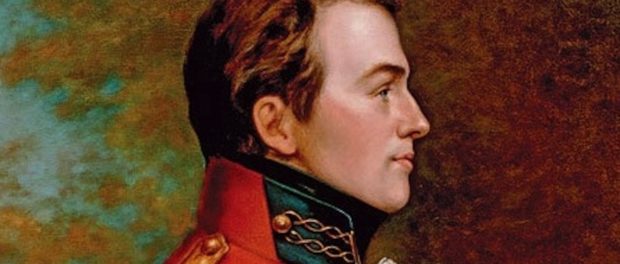1812: Brock at Queenston & Other Quebec Curios
Part of “The Canadas in Britain”, 1792-1827
 Posthumous portrait of Sir Isaac Brock by George Theodore Berthon. Credit: Provincial Archives of Ontario.
Posthumous portrait of Sir Isaac Brock by George Theodore Berthon. Credit: Provincial Archives of Ontario.
Mention the name Sir Isaac Brock and you might be tempted to think that this hero was restricted only to Upper Canada. However, Brock’s military prowess extended to both Canadas. A military man with a history of dealings during the naval missions of the Napoleonic Wars and in the Caribbean, in 1802, the British military assigned Brock, then a relatively young military commander, and his Regiment to Montreal.
Briefly in charge with protecting both Canadas, Brock would concentrate his efforts on Quebec, reinforcing and adding to the fortifications located near the Plains of Abraham and developing the beginnings of a navy. His dealings with protecting Quebec would lead him into conflict with Lower Canadian administrator Thomas Dunn since he would appropriate civilian land and ask for help from civilians to construct the fortifications. Sir James Henry Craig highly rewarded Brock for his efforts and made Brock the commander of Montreal before he transferred Brock to Upper Canada in 1810. It was in Upper Canada that Brock would become a legend.
The two battles that would make Brock a legend even during his own time would be at Detroit, Michigan and his last stand at Queenston in Lower Canada. At Detroit, allying with Shawnee chief Tecumseh, he would help recapture Fort Detroit and the surrounding area from the Americans, led by William Hull. This victory raised the morale of the Canadas and their allies, and would permit them to push onwards against the Americans. It was during this time that Brock and Tecumseh, despite their brief military collaboration, would come to admire one another. During their first meeting, Brock is claimed to have said about Tecumseh “Now there’s a man!” and tales of them leading their fighting forces side by side at Detroit spread. Brock and Tecumseh would exchange military sashes in the presence of both their armies as a token of each other’s high regard of one another; it would be an arrow sash that Brock would be wearing at his last stand at Queenston.
In mid-October of 1812, the Americans would cross the Niagara to take over Queenston Heights. Brock, stationed at Fort George, located further north than the Heights, believed that the Americans would come to them, but nonetheless took a troop of men to investigate the goings-on at the Heights. His belief turned out to be very wrong. Realising his mistake, he would order reinforcements from the 1500 British and the 250 First Nations that were stationed at Fort George. Brock himself would lead, some would say foolishly, the charge to take back Queenston Heights. Fatally shot in the chest, Brock died instantly. Apocryphal tales would have him say some heroic last words before he expired, usually a variant of “Push on, York volunteers!”, though the York volunteers would have arrived on the scene after his death. Even though Brock died in battle, his forces, invigorated with a rage to avenge their commander, would succeed in recapturing Queenston Heights and took 1000 American prisoners.





